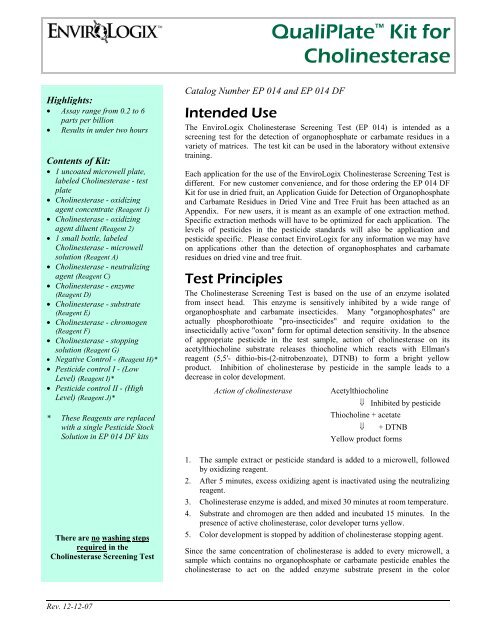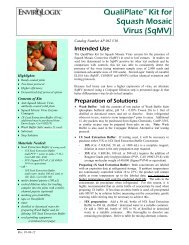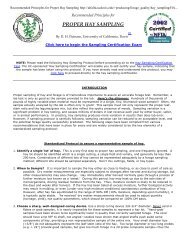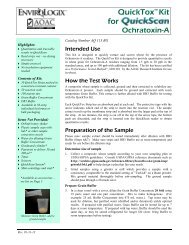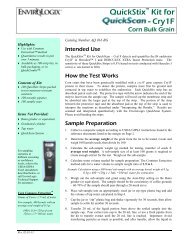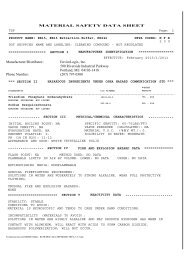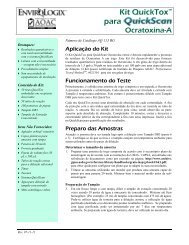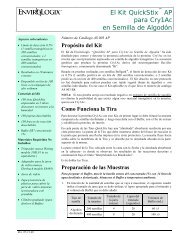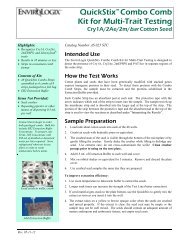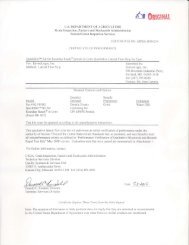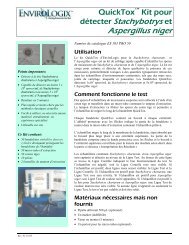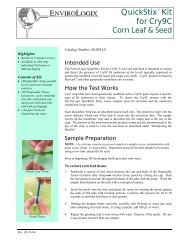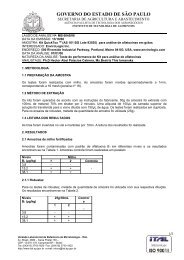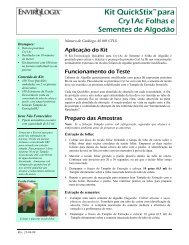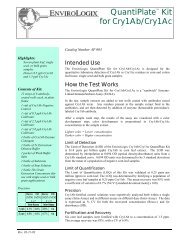QualiPlate™ Kit for Cholinesterase - EnviroLogix
QualiPlate™ Kit for Cholinesterase - EnviroLogix
QualiPlate™ Kit for Cholinesterase - EnviroLogix
Create successful ePaper yourself
Turn your PDF publications into a flip-book with our unique Google optimized e-Paper software.
Highlights:<br />
• Assay range from 0.2 to 6<br />
parts per billion<br />
• Results in under two hours<br />
Contents of <strong>Kit</strong>:<br />
• 1 uncoated microwell plate,<br />
labeled <strong>Cholinesterase</strong> - test<br />
plate<br />
• <strong>Cholinesterase</strong> - oxidizing<br />
agent concentrate (Reagent 1)<br />
• <strong>Cholinesterase</strong> - oxidizing<br />
agent diluent (Reagent 2)<br />
• 1 small bottle, labeled<br />
<strong>Cholinesterase</strong> - microwell<br />
solution (Reagent A)<br />
• <strong>Cholinesterase</strong> - neutralizing<br />
agent (Reagent C)<br />
• <strong>Cholinesterase</strong> - enzyme<br />
(Reagent D)<br />
• <strong>Cholinesterase</strong> - substrate<br />
(Reagent E)<br />
• <strong>Cholinesterase</strong> - chromogen<br />
(Reagent F)<br />
• <strong>Cholinesterase</strong> - stopping<br />
solution (Reagent G)<br />
• Negative Control - (Reagent H)*<br />
• Pesticide control I - (Low<br />
Level) (Reagent I)*<br />
• Pesticide control II - (High<br />
Level) (Reagent J)*<br />
* These Reagents are replaced<br />
with a single Pesticide Stock<br />
Solution in EP 014 DF kits<br />
There are no washing steps<br />
required in the<br />
<strong>Cholinesterase</strong> Screening Test<br />
Rev. 12-12-07<br />
Catalog Number EP 014 and EP 014 DF<br />
QualiPlate <strong>Kit</strong> <strong>for</strong><br />
<strong>Cholinesterase</strong><br />
Intended Use<br />
The <strong>EnviroLogix</strong> <strong>Cholinesterase</strong> Screening Test (EP 014) is intended as a<br />
screening test <strong>for</strong> the detection of organophosphate or carbamate residues in a<br />
variety of matrices. The test kit can be used in the laboratory without extensive<br />
training.<br />
Each application <strong>for</strong> the use of the <strong>EnviroLogix</strong> <strong>Cholinesterase</strong> Screening Test is<br />
different. For new customer convenience, and <strong>for</strong> those ordering the EP 014 DF<br />
<strong>Kit</strong> <strong>for</strong> use in dried fruit, an Application Guide <strong>for</strong> Detection of Organophosphate<br />
and Carbamate Residues in Dried Vine and Tree Fruit has been attached as an<br />
Appendix. For new users, it is meant as an example of one extraction method.<br />
Specific extraction methods will have to be optimized <strong>for</strong> each application. The<br />
levels of pesticides in the pesticide standards will also be application and<br />
pesticide specific. Please contact <strong>EnviroLogix</strong> <strong>for</strong> any in<strong>for</strong>mation we may have<br />
on applications other than the detection of organophosphates and carbamate<br />
residues on dried vine and tree fruit.<br />
Test Principles<br />
The <strong>Cholinesterase</strong> Screening Test is based on the use of an enzyme isolated<br />
from insect head. This enzyme is sensitively inhibited by a wide range of<br />
organophosphate and carbamate insecticides. Many "organophosphates" are<br />
actually phosphorothioate "pro-insecticides" and require oxidation to the<br />
insecticidally active "oxon" <strong>for</strong>m <strong>for</strong> optimal detection sensitivity. In the absence<br />
of appropriate pesticide in the test sample, action of cholinesterase on its<br />
acetylthiocholine substrate releases thiocholine which reacts with Ellman's<br />
reagent (5,5'- dithio-bis-(2-nitrobenzoate), DTNB) to <strong>for</strong>m a bright yellow<br />
product. Inhibition of cholinesterase by pesticide in the sample leads to a<br />
decrease in color development.<br />
Action of cholinesterase Acetylthiocholine<br />
⇓ Inhibited by pesticide<br />
Thiocholine + acetate<br />
⇓ + DTNB<br />
Yellow product <strong>for</strong>ms<br />
1. The sample extract or pesticide standard is added to a microwell, followed<br />
by oxidizing reagent.<br />
2. After 5 minutes, excess oxidizing agent is inactivated using the neutralizing<br />
reagent.<br />
3. <strong>Cholinesterase</strong> enzyme is added, and mixed 30 minutes at room temperature.<br />
4. Substrate and chromogen are then added and incubated 15 minutes. In the<br />
presence of active cholinesterase, color developer turns yellow.<br />
5. Color development is stopped by addition of cholinesterase stopping agent.<br />
Since the same concentration of cholinesterase is added to every microwell, a<br />
sample which contains no organophosphate or carbamate pesticide enables the<br />
cholinesterase to act on the added enzyme substrate present in the color
Items Not Provided<br />
• distilled water (or equivalent)<br />
<strong>for</strong> preparation of calibrators<br />
• application sheet pertaining<br />
to sample type<br />
• microplate reader<br />
• microwell plate mixer<br />
• test tube <strong>for</strong> diluting<br />
oxidizing agent<br />
• automatic pipettes (1-20,<br />
20-200, 200-1000,<br />
1000-5000 µL)<br />
• 12-channel pipette<br />
(20-200 µL)<br />
• marking pens <strong>for</strong> labeling<br />
• timer or wristwatch<br />
a Since extraction methods very often<br />
involve a dilution of sample into<br />
extraction solvent, this dilution must<br />
be taken into account when<br />
determining pesticide levels in the<br />
sample. To calculate the<br />
concentration of pesticide on the<br />
sample, multiply the concentration of<br />
pesticide in the sample extract by any<br />
dilution factor incurred during<br />
extraction. The matrix used <strong>for</strong> these<br />
values was 100% methanol.<br />
b Water samples containing<br />
organophosphates must be collected<br />
in the presence of a minimum of 10%<br />
methanol.<br />
Rev. 12-12-07<br />
QualiPlate <strong>Kit</strong> <strong>for</strong> <strong>Cholinesterase</strong><br />
Page 2 of 6<br />
developer. There<strong>for</strong>e, in the absence of organophosphate or carbamate a dark<br />
yellow color <strong>for</strong>ms. Significant levels of the pesticides will inhibit the action of<br />
the enzyme, resulting in a paler yellow sample.<br />
As with all competitive immunoassays, sample concentration is inversely<br />
proportional to color development.<br />
Darker color = Lower concentration Lighter color = Higher concentration<br />
Per<strong>for</strong>mance Characteristics<br />
The <strong>Cholinesterase</strong> Screening Test is sensitive to a wide range of<br />
organophosphate and carbamate pesticides; other insecticides, fungicides <strong>for</strong><br />
powdery or downy mildew or botrytis control, and herbicides are not detected. It<br />
is important to recognize that different compounds are detected with differing<br />
sensitivities (refer to Table I). Thus, unless the particular pesticide used or<br />
suspected to be used on the sample being tested is known, it is important to<br />
confirm positive results using instrumental (gas chromatography) analyses to<br />
enable identification of the residue present. Where it has been established that<br />
only a single organophosphate or carbamate is present, the test can be used in<br />
conjunction with appropriate standards <strong>for</strong> semi-quantitative testing.<br />
Of the major insecticides used or potentially used, the test detects chlorpyrifos,<br />
methidathion and diazinon with high sensitivity, carbaryl with moderate<br />
sensitivity, and carbofuran residues with lower sensitivity. If samples are being<br />
screened <strong>for</strong> carbamates only (carbaryl, carbofuran), the oxidizing and<br />
neutralizing agent steps can be deleted. Under these conditions, organo(thio)phosphates<br />
are not detected.<br />
Limit of Detection<br />
Limits of detection (15 % inhibition of color development, after oxidizing step)<br />
when organophosphate or carbamate residues are in sample extract or water as<br />
indicated are listed below. See Appendix or specialized product application<br />
guide <strong>for</strong> detection limits in specific samples.<br />
Sensitivity<br />
in Sample<br />
Extract<br />
(ppb) a<br />
Sensitivity<br />
in water<br />
(ppb) b<br />
Sensitivity<br />
in Sample<br />
Extract<br />
(ppb) a<br />
Sensitivity<br />
in water<br />
(ppb) b<br />
Organophosphates<br />
acephate >100,000 methacrifos 500<br />
azinphos-ethyl 5 methamidophos 500<br />
azinphos-methyl 50 10 methidathion 50<br />
chlorfenvinphos 100 mevinphos 50<br />
chlorpyrifos 0.5 0.5 parathion 500 500<br />
chlorpyr-methyl 0.5 parathion-methyl 500<br />
coumaphos 5 phorate 500<br />
diazinon 10 5 phosmet 50<br />
dichlorvos 5 pirimiphos-ethyl 50 100<br />
dimethoate 50,000 pirimiphos-methyl 50<br />
ethion 1000 propetamphos >1000<br />
fenitrothion 200 quinalphos 5<br />
malathion 100 100 triazophos 0.5<br />
Carbamates<br />
carbaryl 1000 100 carbofuran 100 100
Rev. 12-12-07<br />
Preparation of Solutions<br />
QualiPlate <strong>Kit</strong> <strong>for</strong> <strong>Cholinesterase</strong><br />
Page 3 of 6<br />
Sample extraction and preparation of standards in sample matrix<br />
An application sheet specific <strong>for</strong> the sample type to be tested must be obtained<br />
from <strong>EnviroLogix</strong>. For new customer convenience, the Application Sheet <strong>for</strong><br />
Detection of Organophosphate and Carbamate Residues in Dried Vine and Tree<br />
Fruit has been attached as an Appendix. Contact Technical Services <strong>for</strong> your<br />
customized application sheet.<br />
Dilution of Oxidizing agent concentrate (1 % Br2 in 1 M NaBr)<br />
(Caution, this reagent is caustic, handle with care)<br />
On the day of use, <strong>for</strong> each plate, dilute 0.3 mL of Oxidizing agent (Reagent 1) in<br />
2.7 mL oxidizing agent diluent (Reagent 2). Label the diluted oxidizing agent<br />
Reagent B. Discard unused diluted oxidizing agent as it is only stable <strong>for</strong> 24<br />
hours. If less than one plate will be run in one day, dilute only enough oxidizing<br />
agent <strong>for</strong> the number of strips to be used in one day. The volume required per<br />
strip is 0.2 mL (dilute 20 μL in 180 μL) or the required multiple of this dilution<br />
depending on the number of strips to be used.<br />
Chromogen solution (Reagent F)<br />
This reagent may have a yellow precipitate. Just prior to pipetting this reagent,<br />
mix the vial by swirling or inverting to resuspend the precipitate. Re-mix while<br />
pipetting as necessary.<br />
Note: Water used <strong>for</strong> reagents and effect of ambient temperature<br />
The quality of the water and significant variation in laboratory temperature can<br />
influence the total color produced in the assay. The key factor affecting assay<br />
color is the concentration of the enzyme reagent. Please consult <strong>EnviroLogix</strong><br />
be<strong>for</strong>e altering assay conditions.<br />
Pesticide Controls<br />
When an extraction application has not yet been established, three pesticide<br />
controls are provided with this kit. A Negative Control (Reagent H) that contains<br />
only methanol with no pesticide, low pesticide control that contains 10 ppb<br />
diazinon (Reagent I) and a high pesticide control that contains 50 ppb diazinon<br />
(Reagent J). These controls are provided <strong>for</strong> new customers who may not have<br />
negative and positive samples containing known levels of organophosphate or<br />
carbamate pesticides, but would like to see how the assay works. These controls<br />
are not intended to be used in the analysis of sample extracts. In order to properly<br />
analyze sample extracts, pesticide standards, both negative and positive must be<br />
prepared using negative extracts of the matrix to be tested. See below <strong>for</strong> more<br />
in<strong>for</strong>mation concerning the preparation of sample specific pesticide standards<br />
and the extraction of samples.<br />
Preparation of Pesticide Standards<br />
and Extraction of Samples<br />
Each application <strong>for</strong> the use of the <strong>EnviroLogix</strong> <strong>Cholinesterase</strong> Screening Test is<br />
different. For new customer convenience, the Application Sheet <strong>for</strong> Detection of<br />
Organophosphate and Carbamate Residues in Dried Vine and Tree Fruit has been<br />
attached as an Appendix. The inclusion of this application sheet is meant only as<br />
an example of how pesticides are extracted from fruit and how to prepare sample
NC = Negative Control<br />
LO = Reagent I, low level control<br />
HI = Reagent J, high level control<br />
S = Sample extracts<br />
Rev. 12-12-07<br />
QualiPlate <strong>Kit</strong> <strong>for</strong> <strong>Cholinesterase</strong><br />
Page 4 of 6<br />
specific pesticide standards. The application sheet explains how to make<br />
pesticide standards from fruit known to be free of organophosphate and<br />
carbamate residues using a pesticide stock that can be obtained from<br />
<strong>EnviroLogix</strong>. The dried fruit application sheet also describes how to extract<br />
organophosphate and carbamate residues from fruit. Specific extraction methods<br />
will have to be optimized <strong>for</strong> each application. The levels of pesticides in the<br />
pesticide standards will also be application and pesticide specific. Please contact<br />
<strong>EnviroLogix</strong> <strong>for</strong> any in<strong>for</strong>mation we may have on applications other than the<br />
detection of organophosphates and carbamate residues on dried vine and tree<br />
fruit.<br />
How to Per<strong>for</strong>m the Test<br />
NOTE: If microwell plate mixer is not used, gently mix the microwell plate by<br />
swirling in a circular motion 20-30 seconds after the addition of oxidizing agent<br />
(Reagent B), enzyme solution (Reagent D) and chromogen (Reagent F) and then<br />
incubate <strong>for</strong> designated time on bench top.<br />
1. Allow all reagents to reach ambient temperature (at least 22°C) prior to<br />
starting the assay. Cold reagents will result in low OD readings. Remove<br />
the plate from the plastic bag. Any strips that will not be used should be<br />
removed from the holder and returned to the plastic bag. (This is best done<br />
by pressing strip up from the bottom of the holder.)<br />
2. Add 120 µL of microwell solution (Reagent A) to each well.<br />
3. Add 20 µL of extract containing pesticide standard or pesticide controls<br />
(Reagents H, I and J) and sample extracts to each microwell, in duplicate,<br />
using Figure 1 as a guide. Mix microwell contents by swirling <strong>for</strong> 2-3<br />
seconds.<br />
Figure 1. Example of a typical plate setup:<br />
1 2 3 4 5 6 7 8 9 10 11 12<br />
A NC NC S5 S5 S13 S13 S21 S21 S29 S29 S37 S37<br />
B LO LO S6 S6 S14 S14 S22 S22 S30 S30 S38 S38<br />
C HI HI S7 S7 S15 S15 S23 S23 S31 S31 S39 S39<br />
D NC NC S8 S8 S16 S16 S24 S24 S32 S32 S40 S40<br />
E S1 S1 S9 S9 S17 S17 S25 S25 S33 S33 NC NC<br />
F S2 S2 S10 S10 S18 S18 S26 S26 S34 S34 LO LO<br />
G S3 S3 S11 S11 S19 S19 S27 S27 S35 S35 HI HI<br />
H S4 S4 S12 S12 S20 S20 S28 S28 S36 S36 NC NC<br />
4. Make sure that you have diluted the orange oxidizing agent concentrate<br />
(Reagent 1) in oxidizing agent diluent (Reagent 2), immediately be<strong>for</strong>e use.<br />
Immediately add 20 µL of DILUTED oxidizing agent (Reagent B) to each<br />
microwell. Gently mix by swirling the contents of the plate <strong>for</strong> 2-3 seconds.<br />
5. Mix the plates on the microwell plate mixer <strong>for</strong> 5 minutes, then add 20 µL<br />
neutralizing reagent (Reagent C) to each microwell. Mix gently. (NOTE:<br />
If carbamates are the only pesticides being screened the oxidation and<br />
neutralization step may be eliminated.)<br />
6. Immediately add 20 µL cholinesterase enzyme solution (Reagent D). Mix<br />
gently on the microwell plate mixer <strong>for</strong> 30 min at room temperature.<br />
7. Add 20 µL of substrate (Reagent E) and 20 µL of chromogen (Reagent F)<br />
to each microwell. Swirl the plate gently <strong>for</strong> a few seconds, then mix on the
Precautions and<br />
Notes<br />
• Store all QualiPlate <strong>Kit</strong><br />
components at 4°C to 8°C (39°F<br />
to 46°F) when not in use (except<br />
<strong>for</strong> microtiter plate, store this at<br />
room temperature).<br />
• Do not store test kit components<br />
<strong>for</strong> more than 4 hours at ambient<br />
temperatures.<br />
• Do not expose QuantiPlate <strong>Kit</strong><br />
components to temperatures<br />
greater than 37°C (99°F) or<br />
less than 2°C (36°F).<br />
• Allow all reagents to reach<br />
ambient temperature (18°C to<br />
27°C or 64°F to 81°F) be<strong>for</strong>e<br />
use.<br />
• Do not use kit components<br />
after the expiration date.<br />
• Do not use reagents or test<br />
well strips from one QualiPlate<br />
<strong>Kit</strong> with reagents or test well<br />
strips from a different<br />
QualiPlate <strong>Kit</strong>.<br />
• Do not expose Substrate to<br />
sunlight during pipetting or<br />
while incubating in the test<br />
wells.<br />
• As with all tests, it is<br />
recommended that results be<br />
confirmed by an alternate<br />
method when necessary.<br />
• The assay has been optimized<br />
to be used with the protocol<br />
provided in the kit. Deviation<br />
from this protocol may<br />
invalidate the results of the<br />
test.<br />
• Observe any applicable<br />
regulations when disposing of<br />
samples and kit reagents.<br />
Rev. 12-12-07<br />
QualiPlate <strong>Kit</strong> <strong>for</strong> <strong>Cholinesterase</strong><br />
Page 5 of 6<br />
microwell plate mixer <strong>for</strong> 15 minutes. A yellow color develops.<br />
8. After 15 minutes have elapsed, add 20 µL of stopping solution (Reagent G)<br />
to each microwell and mix well. This will arrest the yellow color<br />
development. Read the microwells at 415 nm (ideal) or 405 nm in a<br />
microplate reader. Read the microwells within 30 minutes of stopping the<br />
assay.<br />
Important: At no stage of the procedure are components tipped out of the<br />
microwells or are the microwells washed. Washing will invalidate the<br />
procedure.<br />
Sample Results and Interpretation<br />
If a yellow color does not develop in the pesticide-free fruit extract microwells<br />
within 5 minutes and you have added color developer, the test is invalid and must<br />
be repeated.<br />
Note that this test does not provide the identity of the pesticide in the sample, but<br />
rather an indication that the sample contains an organophosphate or carbamate<br />
pesticide in excess of the "low standards". For identification of the particular<br />
residues present, subsequent analysis of the sample by gas-liquid<br />
chromatography (GLC) is required.<br />
The interpretation of results is specific to the each application. For an example<br />
of a detailed discussion of how to interpret results, see the Sample results and<br />
interpretation section of the attached Application Sheet <strong>for</strong> the detection of<br />
organophosphate and carbamate residues in dried vine and tree fruit.<br />
Below is sample data <strong>for</strong> the pesticide controls (Reagents H, I and J).<br />
Figure 2. Illustrative calculations<br />
Sample Absorbance<br />
% Inhibition<br />
of Negative<br />
Control Pesticide Concentration<br />
Negative<br />
Control<br />
1.040 0<br />
No pesticide present, the highest<br />
absorbance possible in the assay<br />
Low<br />
Control<br />
0.720 30.8<br />
Low pesticide standard (10 ppb<br />
diazinon in standard extract)<br />
High<br />
Control<br />
0.173 83.4<br />
High pesticide standard (50 ppb<br />
diazinon in standard extract)<br />
Actual values may vary; this data is <strong>for</strong> demonstration purposes only.
For Technical Support<br />
Contact Us At:<br />
<strong>EnviroLogix</strong><br />
500 Riverside Industrial<br />
Parkway<br />
Portland, ME 04103-1486<br />
USA<br />
Tel: (207) 797-0300<br />
Toll Free: 866-408-4597<br />
Fax: (207) 797-7533<br />
e-mail:<br />
info@envirologix.com<br />
website:<br />
www.envirologix.com<br />
Rev. 12-12-07<br />
LIMITED WARRANTY<br />
QualiPlate <strong>Kit</strong> <strong>for</strong> <strong>Cholinesterase</strong><br />
Page 6 of 6<br />
<strong>EnviroLogix</strong> Inc. (“<strong>EnviroLogix</strong>”) warrants the products sold hereunder (“the Products”)<br />
against defects in materials and workmanship when used in accordance with the<br />
applicable instructions <strong>for</strong> a period not to extend beyond a product’s printed expiration<br />
date. If the Products do not con<strong>for</strong>m to this Limited Warranty and the customer notifies<br />
<strong>EnviroLogix</strong> in writing of such defects during the warranty period, including an offer by<br />
the customer to return the Products to <strong>EnviroLogix</strong> <strong>for</strong> evaluation, <strong>EnviroLogix</strong> will repair<br />
or replace, at its option, any product or part thereof that proves defective in materials or<br />
workmanship within the warranty period.<br />
ENVIROLOGIX MAKES NO OTHER WARRANTIES, EXPRESSED OR IMPLIED,<br />
INCLUDING BUT NOT LIMITED TO ANY IMPLIED WARRANTIES OF<br />
MERCHANTABILITY OR FITNESS FOR A PARTICULAR PURPOSE. The warranty<br />
provided herein and the data, specifications and descriptions of <strong>EnviroLogix</strong> products<br />
appearing in <strong>EnviroLogix</strong> published catalogues and product literature are <strong>EnviroLogix</strong>’<br />
sole representations concerning the Products and warranty. No other statements or<br />
representations, written or oral, by <strong>EnviroLogix</strong>’ employees, agents or representatives,<br />
except written statements signed by a duly authorized officer of <strong>EnviroLogix</strong> Inc., are<br />
authorized; they should not be relied upon by the customer and are not a part of the<br />
contract of sale or of this warranty.<br />
<strong>EnviroLogix</strong> does not warrant against damages or defects arising in shipping or handling,<br />
or out of accident or improper or abnormal use of the Products; against defects in products<br />
or components not manufactured by <strong>EnviroLogix</strong>, or against damages resulting from such<br />
non-<strong>EnviroLogix</strong> made products or components. <strong>EnviroLogix</strong> passes on to customer the<br />
warranty it received (if any) from the maker thereof of such non-<strong>EnviroLogix</strong> made<br />
products or components. This warranty also does not apply to Products to which changes<br />
or modifications have been made or attempted by persons other than pursuant to written<br />
authorization by <strong>EnviroLogix</strong>.<br />
THIS WARRANTY IS EXCLUSIVE. The sole and exclusive obligation of <strong>EnviroLogix</strong><br />
shall be to repair or replace the defective Products in the manner and <strong>for</strong> the period<br />
provided above. <strong>EnviroLogix</strong> shall not have any other obligation with respect to the<br />
Products or any part thereof, whether based on contract, tort, strict liability or otherwise.<br />
Under no circumstances, whether based on this Limited Warranty or otherwise, shall<br />
<strong>EnviroLogix</strong> be liable <strong>for</strong> incidental, special, or consequential damages.<br />
This Limited Warranty states the entire obligation of <strong>EnviroLogix</strong> with respect to the<br />
Products. If any part of this Limited Warranty is determined to be void or illegal, the<br />
remainder shall remain in full <strong>for</strong>ce and effect.<br />
<strong>EnviroLogix</strong>, the <strong>EnviroLogix</strong> logo, and QualiPlate are trademarks of <strong>EnviroLogix</strong> Inc.<br />
Acknowledgments<br />
Product licensed from CSIRO Plant Industry, Canberra, Australia. Test<br />
development was partly funded by the Dried Fruits R&D Council and the Grape<br />
& Wine R&D Corporation of Australia.<br />
This assay is produced and distributed under an exclusive technology license<br />
from CSIRO Plant Industry (Australia).<br />
© <strong>EnviroLogix</strong> Inc. 2007
~ APPENDIX ~<br />
Application Guide<br />
QualiPlate <strong>Kit</strong> <strong>for</strong> <strong>Cholinesterase</strong><br />
Application Guide <strong>for</strong> the Detection of Organophosphate and<br />
Carbamate Residues in Dried Vine and Tree Fruit<br />
Intended Use<br />
This application guide describes the procedure <strong>for</strong> preparing negative control fruit extracts, fruit extract pesticide standards<br />
and the extraction of pesticide residues from fruit. Directions <strong>for</strong> the interpretation of assay results are also included in this<br />
guide. This <strong>Kit</strong> varies slightly from the main QualiPlate <strong>Kit</strong> <strong>for</strong> <strong>Cholinesterase</strong> in that a Pesticide Stock Solution is supplied<br />
instead of Reagents H, I and J. Follow the instructions in the main product insert to per<strong>for</strong>m the assay.<br />
Be<strong>for</strong>e You Start<br />
You will need several items:<br />
pesticide free fruit (of the same type to be tested)<br />
pesticide standard stock (Supplied by <strong>EnviroLogix</strong>)<br />
blender <strong>for</strong> fruit (optional)<br />
orbital shaker<br />
balance <strong>for</strong> weighing fruit<br />
automatic pipettes (1-20, 20-200)<br />
marking pens <strong>for</strong> bottles of fruit extract<br />
timer or wristwatch<br />
glass bottles/ conical flasks <strong>for</strong> extracting fruit<br />
methanol (analytical reagent grade) <strong>for</strong> extraction of the pesticide from the fruit<br />
100 mL and 1 L measuring cylinders<br />
How to prepare fruit extract pesticide standards and extract the pesticide<br />
from fruit<br />
Introduction<br />
Prior to per<strong>for</strong>ming the <strong>EnviroLogix</strong> Organophosphate Screening Test, fruit extract pesticide standards must be prepared<br />
and pesticides must be extracted from fruit samples. Fruit extract pesticide standards must be prepared from the same type<br />
of fruit being tested.<br />
Pesticide free fruit to be used in the preparation of pesticide fruit standards are extracted using exactly the same method<br />
(and extraction solvent) as the samples to be tested. You will need to prepare a negative, low and high pesticide standard<br />
<strong>for</strong> each fruit type being tested.<br />
Preparation of pesticide standards and extraction of dried vine fruit<br />
Where both the organochlorine and the cholinesterase tests are to be run on the same vine fruit sample, extract the vine fruit<br />
and prepare vine fruit pesticide standards with 100 % methanol. This extracts 70 - 90 % of the organochlorine but only 40-<br />
60 % of the organophosphate or carbamate from vine fruit (which is still sufficient <strong>for</strong> screening purposes). If the test is to<br />
be per<strong>for</strong>med <strong>for</strong> organophosphates and carbamates only, 80 % methanol should be used <strong>for</strong> both vine fruit extract pesticide<br />
standards and extracting organophosphates from vine fruit samples. This extracts over 80% of the target residues from the<br />
sample.<br />
Rev. 12-12-07 A-1
APPENDIX Application Guide~Dried Vine & Tree Fruit<br />
There are two extraction methods that may be used in making the vine fruit extract pesticide standards and extracting<br />
pesticides from vine fruit samples: an overnight soak method or a faster omnimixer technique. The fruit sample size,<br />
extraction method and equipment to be used depends on the particular time and per<strong>for</strong>mance requirements of the user.<br />
Preparation of pesticide standards (dried vine fruit)<br />
The Pesticide Stock Solution containing diazinon (“Diazinon”, “Gesapon”) is supplied with this kit. A low fruit extract<br />
standard (low level of organophosphate) and a high fruit extract standard (higher level of organophosphate) are prepared<br />
from the Pesticide Stock Solution. A negative control (negative fruit extract) will also need to be prepared. The fruit<br />
extract standards and negative control are made in the following manner:<br />
1. Add 20 grams of pesticide-free vine fruit (grapes, sultanas, currants or raisins) to each of three conical flasks. (If the<br />
faster omnimixer method of extract preparation is to be used, chop fruit as described in step 6B below.)<br />
2. To prepare the low level standard, add 20 μL of the pesticide standard stock to the fruit in the first conical flask. This<br />
will produce a final concentration that represents 0.1 ppm diazinon in fruit.<br />
3. To prepare the high level standard, add 200 μL of the pesticide standard stock to fruit in a second available flask . This<br />
will produce a final concentration that represents 1.0 ppm diazinon in fruit. The Australian MRL <strong>for</strong> diazinon in grapes<br />
is currently 0.5 ppm.<br />
4. Add no pesticide standard to the third conical flask; this will be the negative pesticide control.<br />
5. Add 100 mL of 80% or 100% methanol (see explanation of methanol concentration above) to each conical flask. (To<br />
prepare 1 L of 80% methanol, fill a 1L measuring cylinder to the 800 mL mark with methanol. Add water to the 1 L<br />
mark.)<br />
6. One of two methods may be used to prepare fruit extract pesticide standards:<br />
A. Overnight soaking of the sultanas is the simplest method. Whole sultanas (20 g) are shaken 30-60 min in 100 mL<br />
of 80 % or 100 % methanol, swirled by hand <strong>for</strong> 1 minute, then incubated (no shaking) 18-24 hours (overnight) at<br />
room temperature.<br />
B. Rapid blending of sultanas. Sultanas (20 g) are lightly chopped with a sharp knife and blended in 100 mL of 80 %<br />
or 100 % methanol <strong>for</strong> 2 minutes using an Omnimixer.<br />
Pesticide free fruit to be used in the preparation of pesticide fruit standards are extracted using exactly the same method<br />
(and extraction solvent) as the samples to be tested. If covered to prevent evaporation, the extracts of the fruit containing<br />
pesticide standards are stable <strong>for</strong> 48 hours at room temperature. These standards should be prepared and analysed at the<br />
same time as the sample grape, sultana or currant extracts being tested.<br />
Extracts should not require filtration be<strong>for</strong>e use, but just settling. Do not disturb the sediment in the bottom of extraction jar<br />
when pipetting extract. Note that other solvents such as methylated spirits should not be used as they interfere with the test,<br />
and produce erroneous results.<br />
Since action levels vary between markets, results obtained should be interpreted with respect to the target end-market.<br />
Extraction of pesticides from dried vine fruit samples<br />
Be<strong>for</strong>e they can be analysed in the test, organophosphates and carbamates must be extracted from the sultanas using either<br />
80 or 100% methanol (see explanation of methanol concentration in introduction section). Use exactly the same method of<br />
extraction of pesticides from fruit samples as was used to prepare fruit extract pesticide standards. Choose one of the two<br />
methods listed below.<br />
1. Overnight soaking of the sultanas is the simplest method. Whole sultanas (20 g) are shaken 30-60 min in 100 mL of 80<br />
% or 100 % methanol, swirled by hand <strong>for</strong> 1 minute, then incubated (no shaking) 18-24 hours (overnight) at room<br />
temperature.<br />
2. Rapid blending of sultanas. Sultanas (20 g) are lightly chopped with a sharp knife and blended in 100 mL of 80 % or<br />
100 % methanol <strong>for</strong> 2 minutes using an Omnimixer.<br />
Note : Role of fruit type Samples should be compared to zero, low and high-pesticide standards of the same fruit type (e.g.<br />
Carina currant extracts must be compared against standards prepared in Carina currant extract).<br />
Rev. 12-12-07 A-2
APPENDIX Application Guide~Dried Vine & Tree Fruit<br />
There are five main groups:<br />
- dipped sultanas, dipped raisins, - natural sultanas/ raisins, Zante currants, Carina currants<br />
Carina currants are larger and darker than Zante currants; the color of the methanol extract is darker and a purple color. For<br />
more accurate results these should be distinguished from one another and separate standards run <strong>for</strong> each type of fruit.<br />
Although the sensitivity of the assay is similar in each dried fruit type, the color produced in pesticide-free controls (i.e.<br />
zero-pesticide standards) can vary slightly but significantly. For example, Carina currants may produce 15 % higher color in<br />
pesticide-free standards than Zante currants, while sultanas produce even lower color. The percentage inhibition of color<br />
produced by the low and high pesticide standard is usually slightly lower (5-10 %) with currants and naturals than with<br />
dipped sultanas.<br />
Preparation of pesticide standards and extraction of dried tree fruit<br />
Preparation of pesticide standards (dried tree fruit)<br />
The Pesticide Stock Solution containing diazinon (“Diazinon”, “Gesapon”) is supplied with this kit. A low fruit extract<br />
standard (low level of organophosphate) and a high fruit extract standard (higher level of organophosphate) are prepared<br />
from the Pesticide Stock Solution. A negative control (negative fruit extract) will also need to be prepared. The fruit<br />
extract standards and negative control are made in the following manner:<br />
1. Add 40 grams of pesticide-free tree fruit to each of three conical flasks.<br />
2. To prepare the low level standard, add 40 μL of the pesticide standard stock to the fruit in the first conical flask. This<br />
will produce a final concentration that represents 0.1 ppm diazinon in fruit.<br />
3. To prepare the high level standard, add 400 μL of the pesticide standard stock to fruit in a second available flask . This<br />
will produce a final concentration that represents 1.0 ppm diazinon in fruit.<br />
4. Add no pesticide standard to the third conical flask; this will be the negative pesticide control.<br />
5. The dried tree fruit must be swelled with distilled (or equivalent) water by soaking 40 g fruit in 40 mL water <strong>for</strong> four to<br />
six hours.<br />
6. After swelling, add 160 mL of methanol and extract overnight while shaking.<br />
Pesticide free fruit to be used in the preparation of pesticide fruit standards are extracted using exactly the same method<br />
(and extraction solvent) as the samples to be tested. If covered to prevent evaporation, the extracts of the fruit containing<br />
pesticide standards are stable <strong>for</strong> 48 hours at room temperature. These standards should be prepared and analysed at the<br />
same time as the sample dried tree fruit extracts being tested.<br />
Extracts should not require filtration be<strong>for</strong>e use, but just settling. Do not disturb the sediment in the bottom of extraction jar<br />
when pipetting extract. Note that other solvents such as methylated spirits should not be used as they interfere with the test,<br />
and produce erroneous results.<br />
Since action levels vary between markets, results obtained should be interpreted with respect to the target end-market.<br />
Extraction of pesticides from dried tree fruit samples Be<strong>for</strong>e they can be analysed in the test, organophosphates and<br />
carbamates must be extracted from the dried tree fruit using the procedure listed in steps 5 and 6 above.<br />
Sample results and interpretation<br />
If a yellow color does not develop in the pesticide-free fruit extract microwells within 5 minutes after you have added color<br />
developer, the test is invalid and must be repeated.<br />
1. Measure and record the absorbance of each microwell. Average the absorbance of each pair of duplicate wells.<br />
Compare the means of absorbances obtained with each sample to that of the means of the negative control (pesticidefree<br />
fruit extract), and to the pesticide standards.<br />
2. If the Absorbance of the sample is less than the Absorbance of the chosen pesticide standard by at least 0.1 unit, the<br />
sample contains organophosphate or carbamate greater than or equal to the limits shown in Table I (page 5) <strong>for</strong> dried<br />
vine fruit and Table II (page 6) <strong>for</strong> dried tree fruit in this insert. It is recommended that fruit providing absorbance<br />
values below that provided by the low pesticide standard be considered as potentially contaminated fruit.<br />
Rev. 12-12-07 A-3
APPENDIX Application Guide~Dried Vine & Tree Fruit<br />
3. If fruit is to be retested, it is best that it be re-extracted <strong>for</strong> testing. If this is not possible, and the extract is to be retested<br />
the next day, it is recommended that the liquid extract be taken off the fruit and stored in a sealed glass container. This<br />
is especially important with currants, as the extract continues to get darker with time.<br />
4. Note that this test does not provide the identity of the pesticide in the sample, but rather an indication that the sample<br />
contains an organophosphate or carbamate pesticide in excess of the "low standards". For identificaton of the particular<br />
residues present, subsequent analysis of the sample by gas-liquid chromatography (GLC) is required.<br />
Sample Data<br />
Sample Absorbance Interpretation<br />
Control 1.06 zero pesticide-in-fruit standard - mean of 4 controls<br />
Low standard 0.67 low pesticide standard (0.1 ppm diazinon-in-fruit)<br />
High standard 0.38 high pesticide standard (1 ppm diazinon-in-fruit)<br />
S1 0.97 Since the difference between the sample absorbance and the control<br />
is less that 0.1, this is considered to be a negative test.<br />
Residues are within acceptable limits.<br />
S2 0.60 Concentration is more than the low pesticide standard - positive test.<br />
Notes • The “action” inhibition level must be determined by the industry. The low calibrator contains 0.1 ppm diazinon,<br />
which is 20 % of the Australian MRL <strong>for</strong> that compound.<br />
Table I: Limits of detection (15 % inhibition of color development, after oxidizing step) in grapes and sultanas of<br />
organophosphates and carbamate insecticides used in Australia.<br />
Compound Sensitivity: limit of detection in grapes and sultanas (ppm) a<br />
Aust. MRL Grapes Sultanas Currants<br />
Major compounds<br />
Organophosphates<br />
Chlorpyrifos (Lorsban) 0.01 b 0.0002 0.001 0.002<br />
Diazinon (Basudin) 0.5 0.05 0.05 0.05<br />
Methidathion (Supracide) 0.5 0.1 0.1 0.2<br />
Carbamates<br />
Carbaryl (Bugmaster, Sevin) 5 0.5 0.5 0.5<br />
Methomyl (Lannate, Nudrin, Marlin) 2 1 1 1.5<br />
Minor use compounds<br />
Azinphos-methyl 2<br />
Dimethoate 2 1.5 1 1<br />
Fenitrothion (Folithion, Sumithion) 0.5 0.2 0.5 0.5<br />
Maldison (Malathion, Hymal) 8 0.1 0.1 0.2<br />
Methiocarb (Baysol, Mesurol) 0.1<br />
Parathion 0.5 0.1 0.1 0.2<br />
Parathion-methyl 1 0.5 0.5<br />
Promecarb (Carbamult) 0.2 0.02 0.1<br />
Prothiofos (Tokuthion) 2<br />
Trichlofon 0.1<br />
a This assumes extraction of over 80 % of the target residues from the sample, using 80 % methanol. If 100 % methanol is<br />
used as the extractant, the sensitivity is approximately halved.<br />
b Recently increased <strong>for</strong> grapes and sultanas<br />
Rev. 12-12-07 A-4
APPENDIX Application Guide~Dried Vine & Tree Fruit<br />
Table II: Limits of detection (20 % inhibition of color development, after oxidizing step) in dried tree fruit of<br />
organophosphates and carbamate insecticides used in Australia.<br />
Compound Sensitivity: limit of detection in dried tree fruit (ppm)<br />
Major compounds<br />
Peaches Prunes Apricot Pears<br />
Organophosphates<br />
Diazinon (Basudin) 0.04 0.06 0.1 0.02<br />
Carbamates<br />
Carbaryl (Bugmaster, Sevin) 0.2 0.5 1.0 0.5<br />
Rev. 12-12-07 A-5


